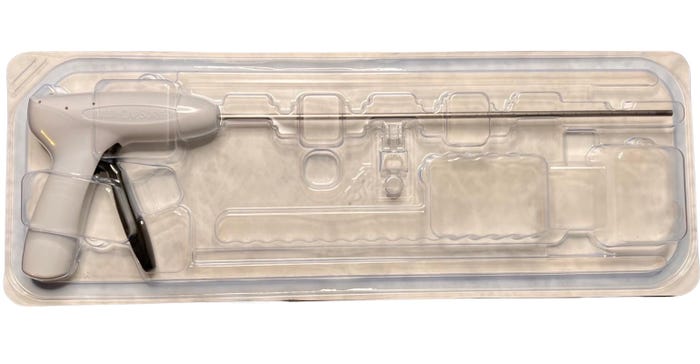Medical Device Gains Eco Advantages with Rigid Package
By switching from a pouch to a rigid tray with a miniature retainer, BD secured its hernia repair device and reduced plastic by 25% for economic and eco-friendly improvements.

It’s not often you hear about a company improving its sustainability by switching from a flexible pouch to a rigid tray. Usually, it’s the other way around. Yet that’s what this medical device manufacturer achieved, along with myriad material, manufacturing, cost, and assembly savings.
With a primary goal of cutting costs, Becton Dickinson sought an alternative flexible packaging system for CapSure, a permanent fixation device for hernia repairs. But when similar materials proved inferior, the company took a different approach: It combined a thermoformed rigid tray with a miniature injection-molded retainer called SEEkeyMD.
The new package design, which won a 2022 AmeriStar Award from the Institute of Packaging Professionals (IoPP), replaces a 30-mil solid-bleached sulfate (SBS) paperboard card, a shaft tube protector, and a 10.5 x 28-inch foil pouch. Combining the 1-gram retainer with the rigid tray provided much-needed support, allowing BD to reduce the tray’s sheet thickness from 40 to 30 mil — a plastic savings of 25%. The tray with the retainer is sealed with Tyvek, eliminating the sterile barrier integrity risks associated with the flexible pouch system.
The key to compatibility.
The SEEkeyMD provides exceptional holding strength, pinning the device to the tray and mitigating particulates during vibration testing. In turn, the rigid tray contours to the device in two planes and accepts the SEEkeyMD mold inserts while maintaining a low tool investment. The key design also passed 100% of the drop tests using one key and a handle snap-lock to prevent device rotation.
Made from high-density polyethylene (HDPE), the miniature key’s resin surface friction is compatible with all common base tray resins. Its mold insert improves both plastic thinning and minimum material thickness, while still ensuring the sterile barrier by minimizing damage during shipping and storage.
In terms of manufacturing advantages, the key system enables an innovative tray release from the mold, which improves the base tray ejection from the thermoformed mold. This allows for a larger form tool size that reduces machine time and cost. For miniature retainer standardization, the mold inserts adjust to many rigid tray material thicknesses.
Economics and efficiencies.
In comparison to the previous pouch system, the tray combined with SEEkeyMD and sealed with Tyvek has resulted in a 35% overall cost savings. A generous 7-degree sidewall base tray draft has aided a 25% material gauge reduction. According to BD, this draft angle is uncommon when securing this type of medical device and is made possible with the large contact area SEEkeyMD provides.
Furthermore, the HDPE resin used to make SEEkeyMD is half the cost of the rigid tray resin. Since SEEkeyMD is a standardized retainer, BD will incur future savings on this project when adding additional trays that use this system.
The new packaging has also yielded a 75% assembly time savings: Key insertion has reduced loading motions from nine to one, saving assemblers 20 seconds per device. The move from pouch sealing to Tyvek-to-tray sealing has increased manufacturing output, and the sterile barrier seal inspection of filled trays is faster than the pouch seal inspection.
The new package has a 24% smaller footprint, which provides more storage space at the hospital. And, with this design, nurses can see and inspect the device through the clear tray prior to opening. Plus, the Tyvek seal opens more easily than the pouch.
With the introduction of the new package design, BD changed device entry into the sterile field from open/dump to open/present. This has eliminated all packaging waste (SBS card and tube protector) from entering the sterile field.
Charles Kanazeh, Associate Director, Labeling & Packaging Engineering, BD Interventional – Surgery, explains the significance of this: “Based on my experience and knowledge, all the material and/or items that go into the sterile field must be managed and accounted for and typically go into the biowaste. Items that stay outside the sterile field may be recycled if the facility has those programs in place.”
The package design, however, also allows easy open/dump presentation into the sterile field. For open/dump presentations, a simple downward push releases the device from the tray.
Kanazeh continues, “The new SEEkey design allows for the device to be secured and safely locked into place until the end users push the SEEkey to unlock the device. This is beneficial as it allows the end user to remove the device freely and safely from the tray, as opposed to the ridge tray designs that have overly aggressive snaps for device security resulting in potential damaged products and frustration through the end user having to aggressively pull, twist, bend, shake, and even pry the device from its package. Therefore, it is my opinion that this new design increases efficiency and the end user satisfaction while minimizing the sterile field waste.”
About the Author(s)
You May Also Like




